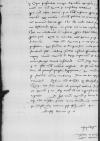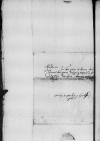 BCz, 1597, p. 1119
BCz, 1597, p. 1119
Reverendissime in Christo Pater, excellentissime domine antistes, domine gratiose.
Obsequia nostra paratissima sint in Reverendissimae Paternitatis Vestrae vota ex sententia destinata.
Reverendissime ac ms. a(!)
⌈acac ms. a(!)
⌉ gratiose Domine.
Non est incognitum Vestrae Reverendissimae Paternitati, quibus verbis quaesti sumus de damnis et praeiudiciis per nobilem dominum Friedrich von der Ölsnitz (*1490 – †1553), at least in 1539-1550 grand marshal of duke Albrecht von Hohenzollern; captain (Hauptmann) of Hohenstein (HARTMANN 1525-1550)⌊Fredericum ab OlsnitzFriedrich von der Ölsnitz (*1490 – †1553), at least in 1539-1550 grand marshal of duke Albrecht von Hohenzollern; captain (Hauptmann) of Hohenstein (HARTMANN 1525-1550)⌋, capitaneum in Hohenstein (Olsztynek), town in Ducal Prussia, 26 km S of Allenstein (Olsztyn)⌊HohensteinHohenstein (Olsztynek), town in Ducal Prussia, 26 km S of Allenstein (Olsztyn)⌋, illustrissimi Albrecht I von Hohenzollern-Ansbach (Albrecht von Brandenburg) (*1490 – †1568), 1511-1525 Grand Master of the Teutonic Order; from 1525 to his death Duke in Prussia as a liegeman of the Polish king; son of Friedrich V of Brandenburg der Ältere and Sophia Jagiellon (daughter of Casimir IV Jagiellon), nephew of Sigismund I, King of Poland; founder of the university in Königsberg (1544)⌊principis PrussiaeAlbrecht I von Hohenzollern-Ansbach (Albrecht von Brandenburg) (*1490 – †1568), 1511-1525 Grand Master of the Teutonic Order; from 1525 to his death Duke in Prussia as a liegeman of the Polish king; son of Friedrich V of Brandenburg der Ältere and Sophia Jagiellon (daughter of Casimir IV Jagiellon), nephew of Sigismund I, King of Poland; founder of the university in Königsberg (1544)⌋ marschalcum, in alveo Passarge (Pasłęka, Passerie), river on the border between Royal and Ducal Prussia⌊PassariaePassarge (Pasłęka, Passerie), river on the border between Royal and Ducal Prussia⌋ dicto factis et communi tam Vestae Reverendissimae Dominationis quam nostra iactura extructis.
Nam proxima sexta feria unum de medio fratrum nostrorum una cum Reverendissimae Paternitatis Vestrae capitaneo Braunsbergensi etc. eodem ablegavimus. Qui compererunt ita liberum alvei fluxum obstructurum et contra patria iura et consuetudinem ab una ripa ad alteram palis roboribus saxis et terra impeditum, quod lignis asseribus et aliis necessariis in civitates Braunsberg (Braniewo), town in Ermland (Warmia), 19 km NE of Elbing (Elbląg), port on the Vistula Lagoon, a member of the Hanseatic League⌊BraunsberckBraunsberg (Braniewo), town in Ermland (Warmia), 19 km NE of Elbing (Elbląg), port on the Vistula Lagoon, a member of the Hanseatic League⌋, Wormditt (Orneta), town in Ermland (Warmia), 30 km W of Heilsberg (Lidzbark Warmiński)⌊WormenytWormditt (Orneta), town in Ermland (Warmia), 30 km W of Heilsberg (Lidzbark Warmiński)⌋ etc. necnon et alia dominia Reverendissimae Paternitatis Vestrae defluitandis omnino factus sit inutilis et inabilis atque mole Vestrae Reverendissimae Paternitatis in Braunsberck multum nocivus.
Fuisset itaque ex re et Reverendissimae Paternitatis Vestrae, et nostra iam longe ante illustrissimo Albrecht I von Hohenzollern-Ansbach (Albrecht von Brandenburg) (*1490 – †1568), 1511-1525 Grand Master of the Teutonic Order; from 1525 to his death Duke in Prussia as a liegeman of the Polish king; son of Friedrich V of Brandenburg der Ältere and Sophia Jagiellon (daughter of Casimir IV Jagiellon), nephew of Sigismund I, King of Poland; founder of the university in Königsberg (1544)⌊principi PrussiaeAlbrecht I von Hohenzollern-Ansbach (Albrecht von Brandenburg) (*1490 – †1568), 1511-1525 Grand Master of the Teutonic Order; from 1525 to his death Duke in Prussia as a liegeman of the Polish king; son of Friedrich V of Brandenburg der Ältere and Sophia Jagiellon (daughter of Casimir IV Jagiellon), nephew of Sigismund I, King of Poland; founder of the university in Königsberg (1544)⌋ ea de causa scripsisse nec hodie cessandum est, priusquam haec structura nostra conviventia fixum pedem firmet. Quare instanter Vestrae Reverendissimae Paternitati supplicamus, dignetur iam tandem se apud dictum dominum Albrecht I von Hohenzollern-Ansbach (Albrecht von Brandenburg) (*1490 – †1568), 1511-1525 Grand Master of the Teutonic Order; from 1525 to his death Duke in Prussia as a liegeman of the Polish king; son of Friedrich V of Brandenburg der Ältere and Sophia Jagiellon (daughter of Casimir IV Jagiellon), nephew of Sigismund I, King of Poland; founder of the university in Königsberg (1544)⌊principemAlbrecht I von Hohenzollern-Ansbach (Albrecht von Brandenburg) (*1490 – †1568), 1511-1525 Grand Master of the Teutonic Order; from 1525 to his death Duke in Prussia as a liegeman of the Polish king; son of Friedrich V of Brandenburg der Ältere and Sophia Jagiellon (daughter of Casimir IV Jagiellon), nephew of Sigismund I, King of Poland; founder of the university in Königsberg (1544)⌋ interponere et litteris efficere, ne dominus Friedrich von der Ölsnitz (*1490 – †1553), at least in 1539-1550 grand marshal of duke Albrecht von Hohenzollern; captain (Hauptmann) of Hohenstein (HARTMANN 1525-1550)⌊marschalcusFriedrich von der Ölsnitz (*1490 – †1553), at least in 1539-1550 grand marshal of duke Albrecht von Hohenzollern; captain (Hauptmann) of Hohenstein (HARTMANN 1525-1550)⌋ privatae suae commoditatis studio exstruat, de quo plures detrimentum et Ermland Chapter cathedral chapter based in Frauenburg (Frombork, Varmia)⌊venerabile capitulumErmland Chapter cathedral chapter based in Frauenburg (Frombork, Varmia)⌋ in bonis et iure dominii suis praeiudicium capiat.
Scripsimus nos quoque ad Albrecht I von Hohenzollern-Ansbach (Albrecht von Brandenburg) (*1490 – †1568), 1511-1525 Grand Master of the Teutonic Order; from 1525 to his death Duke in Prussia as a liegeman of the Polish king; son of Friedrich V of Brandenburg der Ältere and Sophia Jagiellon (daughter of Casimir IV Jagiellon), nephew of Sigismund I, King of Poland; founder of the university in Königsberg (1544)⌊suam illustrem gratiamAlbrecht I von Hohenzollern-Ansbach (Albrecht von Brandenburg) (*1490 – †1568), 1511-1525 Grand Master of the Teutonic Order; from 1525 to his death Duke in Prussia as a liegeman of the Polish king; son of Friedrich V of Brandenburg der Ältere and Sophia Jagiellon (daughter of Casimir IV Jagiellon), nephew of Sigismund I, King of Poland; founder of the university in Königsberg (1544)⌋, prout Vestra Reverendissima Paternitas  BCz, 1597, p. 1120 ex copia praesentibus annexa dignabitur cognoscere (si modo ita Vestrae Reverendissimae Paternitati consultum videbitur)[1]. Non esset etiam abs re Reverendissimae Paternitatis Vestrae litteris inserere perpetuae pacis articulum, quo cavetur omnes fluvios et torrentes Prussia, region in central Europe, bordered by Pomerania, Poland, Lithuania and Livonia. From 1466 Prussia was divided into Royal Prussia (Prussia Regalis), which was a part of the Kingdom of Poland, and Teutonic Prussia (Prussia Ordinis Theutonici) – covering the remnants of the former territory of the Teutonic Order’s state in Prussia. In 1525, the Order’s last Grand Master, Albrecht von Hohenzollern, converted to Lutheranism and became the first lay duke in former Teutonic Prussia (dux in Prussia), which from then on was called Ducal Prussia (Prussia Ducalis). At that time, as a result of the treaty of Cracow, Ducal Prussia became a fief of the kings of Poland⌊harum terrarumPrussia, region in central Europe, bordered by Pomerania, Poland, Lithuania and Livonia. From 1466 Prussia was divided into Royal Prussia (Prussia Regalis), which was a part of the Kingdom of Poland, and Teutonic Prussia (Prussia Ordinis Theutonici) – covering the remnants of the former territory of the Teutonic Order’s state in Prussia. In 1525, the Order’s last Grand Master, Albrecht von Hohenzollern, converted to Lutheranism and became the first lay duke in former Teutonic Prussia (dux in Prussia), which from then on was called Ducal Prussia (Prussia Ducalis). At that time, as a result of the treaty of Cracow, Ducal Prussia became a fief of the kings of Poland⌋ liberos esse nec ullo modo liberum fluxum aut defluitandi usum in parte aut in toto impediri debere. Nos non audebamus eum inserere propter defectum litterarum perpetuae pacis, quas in manibus Vestrae Reverendissimae Paternitatis esse non dubitamus.
BCz, 1597, p. 1120 ex copia praesentibus annexa dignabitur cognoscere (si modo ita Vestrae Reverendissimae Paternitati consultum videbitur)[1]. Non esset etiam abs re Reverendissimae Paternitatis Vestrae litteris inserere perpetuae pacis articulum, quo cavetur omnes fluvios et torrentes Prussia, region in central Europe, bordered by Pomerania, Poland, Lithuania and Livonia. From 1466 Prussia was divided into Royal Prussia (Prussia Regalis), which was a part of the Kingdom of Poland, and Teutonic Prussia (Prussia Ordinis Theutonici) – covering the remnants of the former territory of the Teutonic Order’s state in Prussia. In 1525, the Order’s last Grand Master, Albrecht von Hohenzollern, converted to Lutheranism and became the first lay duke in former Teutonic Prussia (dux in Prussia), which from then on was called Ducal Prussia (Prussia Ducalis). At that time, as a result of the treaty of Cracow, Ducal Prussia became a fief of the kings of Poland⌊harum terrarumPrussia, region in central Europe, bordered by Pomerania, Poland, Lithuania and Livonia. From 1466 Prussia was divided into Royal Prussia (Prussia Regalis), which was a part of the Kingdom of Poland, and Teutonic Prussia (Prussia Ordinis Theutonici) – covering the remnants of the former territory of the Teutonic Order’s state in Prussia. In 1525, the Order’s last Grand Master, Albrecht von Hohenzollern, converted to Lutheranism and became the first lay duke in former Teutonic Prussia (dux in Prussia), which from then on was called Ducal Prussia (Prussia Ducalis). At that time, as a result of the treaty of Cracow, Ducal Prussia became a fief of the kings of Poland⌋ liberos esse nec ullo modo liberum fluxum aut defluitandi usum in parte aut in toto impediri debere. Nos non audebamus eum inserere propter defectum litterarum perpetuae pacis, quas in manibus Vestrae Reverendissimae Paternitatis esse non dubitamus.
Ut autem Reverendissima Paternitas Vestra cognoscat ad perfectum, quae praeiudicia et damna sint nobis per dictam hidden by binding⌈[tam]tam hidden by binding⌉ structuram facta, dedimus praesentibus nostris officialibus id negotii Vestram Reverendissimam Dominationem desuper informandam et de omnibus circumstantiis latius resolvendi.
Si itaque Reverendissima Paternitas Vestra istis nostris motivis accesserit et ipsa etiam litteras dare ad Albrecht I von Hohenzollern-Ansbach (Albrecht von Brandenburg) (*1490 – †1568), 1511-1525 Grand Master of the Teutonic Order; from 1525 to his death Duke in Prussia as a liegeman of the Polish king; son of Friedrich V of Brandenburg der Ältere and Sophia Jagiellon (daughter of Casimir IV Jagiellon), nephew of Sigismund I, King of Poland; founder of the university in Königsberg (1544)⌊principem PrussiaeAlbrecht I von Hohenzollern-Ansbach (Albrecht von Brandenburg) (*1490 – †1568), 1511-1525 Grand Master of the Teutonic Order; from 1525 to his death Duke in Prussia as a liegeman of the Polish king; son of Friedrich V of Brandenburg der Ältere and Sophia Jagiellon (daughter of Casimir IV Jagiellon), nephew of Sigismund I, King of Poland; founder of the university in Königsberg (1544)⌋ disposuerit (quod Vestram Reverendissimam Paternitatem facturam minime ambigimus, immo ut det, obsequenter oramus). Extunc nostro burgrabio ex Mehlsack (Melzak), town in Ermland (Warmia), 32 km SE of Frauenburg (Frombork), today Pieniężno⌊MeelsackMehlsack (Melzak), town in Ermland (Warmia), 32 km SE of Frauenburg (Frombork), today Pieniężno⌋ iniunximus, ut inde recta ad Albrecht I von Hohenzollern-Ansbach (Albrecht von Brandenburg) (*1490 – †1568), 1511-1525 Grand Master of the Teutonic Order; from 1525 to his death Duke in Prussia as a liegeman of the Polish king; son of Friedrich V of Brandenburg der Ältere and Sophia Jagiellon (daughter of Casimir IV Jagiellon), nephew of Sigismund I, King of Poland; founder of the university in Königsberg (1544)⌊principemAlbrecht I von Hohenzollern-Ansbach (Albrecht von Brandenburg) (*1490 – †1568), 1511-1525 Grand Master of the Teutonic Order; from 1525 to his death Duke in Prussia as a liegeman of the Polish king; son of Friedrich V of Brandenburg der Ältere and Sophia Jagiellon (daughter of Casimir IV Jagiellon), nephew of Sigismund I, King of Poland; founder of the university in Königsberg (1544)⌋ declinet et istinc ad Reverendissimam Paternitatem Vestram atque tandem ad nos responsales litteras reportet.
Et his Vestram Reverendissimam Paternitatem aeterno Deo, atque nos eiusdem gratiae unice commendamus.
 BCz, 1597, p. 1120 ex copia praesentibus annexa dignabitur cognoscere (si modo ita Vestrae Reverendissimae Paternitati consultum videbitur)[1]. Non esset etiam abs re Reverendissimae Paternitatis Vestrae litteris inserere perpetuae pacis articulum, quo cavetur omnes fluvios et torrentes
BCz, 1597, p. 1120 ex copia praesentibus annexa dignabitur cognoscere (si modo ita Vestrae Reverendissimae Paternitati consultum videbitur)[1]. Non esset etiam abs re Reverendissimae Paternitatis Vestrae litteris inserere perpetuae pacis articulum, quo cavetur omnes fluvios et torrentes 





